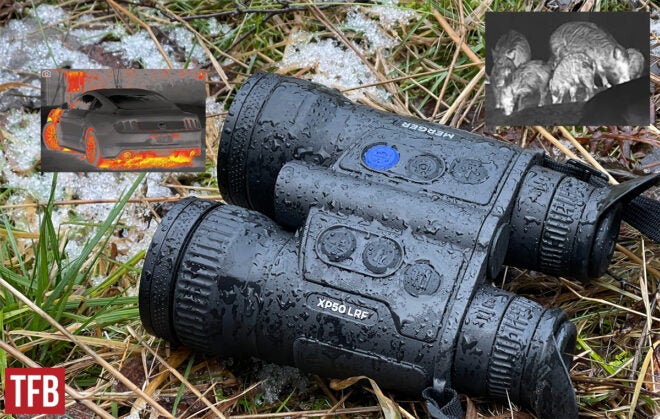This is a review of the Pulsar Merger LRF XP50 Thermal Binoculars. The closest thing we’ve ever had a look at here is the almost three-year-old review of the Pulsar Accolade 2 LRF XP50, and things have certainly moved on during that time. Apart from one thing, everything has been improved!
Pulsar Vision @ TFB:
- Pulsar Telos: New Premium Line of Upgradable Thermal Monoculars
- New Pulsar Thermion Duo DXP50: 4k Full-Color Daytime + Thermal Riflescope
- [IWA 2023] NEW Pulsar Thermal Rifle Scopes
- [IWA 2023] Pulsar Krypton 2 – Upgraded Thermal Imaging Attachments
- TFB Review: Pulsar Thermion 2 LRF XP50 Pro Thermal Riflescope
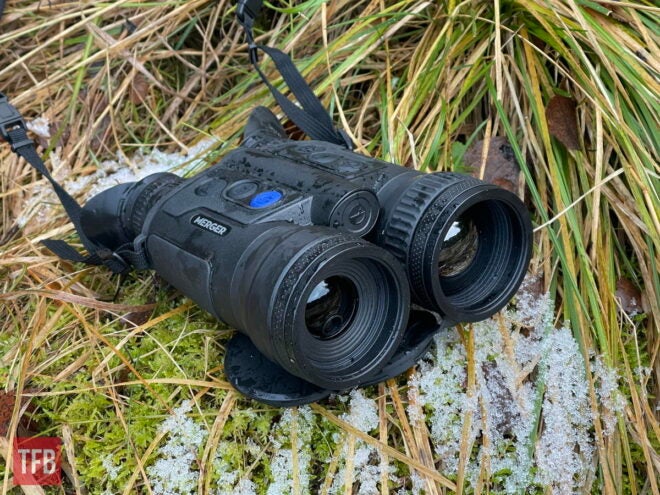
First of all, the design has evolved considerably from the previous model, and the unit is now designed like a traditional handheld binocular. Overall, this is a big step forward when it comes to ergonomics, but I also see other benefits when thermal devices look like traditional optics – less questions asked, and less “weirdness” around their use and their users.
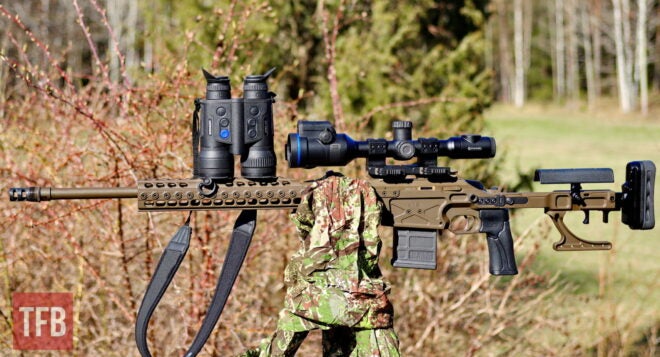
Tikka T3x TAC A1 in 6.5 Creedmoor. The Merger XL balances on a Spuhr SICS chassis, Cerakoted in Snigel Grey. The riflescope is the new Thermion Duo DXP55 with both a 4K sight and a powerful thermal lens.
Introduction
One of the challenges with writing a review about thermal imaging devices like this Merger is to create the correct level of content. Inevitably there will be readers here who won’t understand much about thermals, and how the technology can be used. At the same time, there will be some readers complaining about why the article isn’t advanced enough, and not going into deep detail about certain things. I will try to “walk the middle”.
These binoculars are equipped with a high-resolution thermal sensor, which allows you to see heat signatures even in complete darkness (but also during daylight). The sensor has a thermal resolution of 640×480 pixels, which provides a clear and detailed image. The images can be recorded with the on-board camera, or displayed on your iPad or similar handheld device.
Below: There used to be a time when I wondered why on Earth I would ever need any sort of night vision or thermal binoculars, now I’m not sure how I could live without them. In a driven hunt, they’re excellent to keep track of dogs and their handlers so you know which areas are safe or not. It made my last hunt a lot more interesting, and I definitely knew more about what was going on around me than the others.
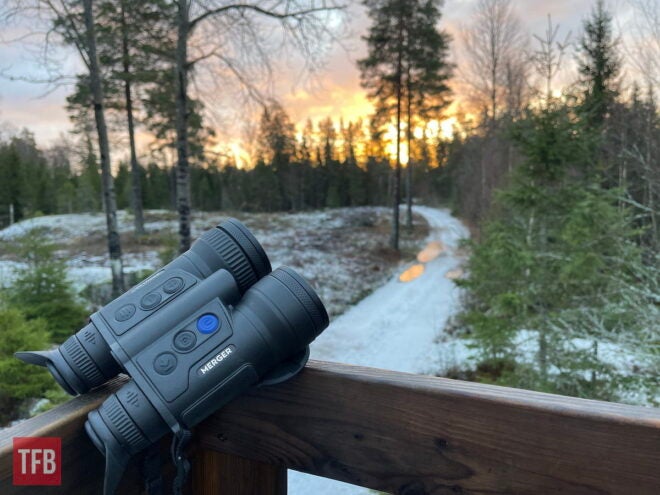
Below: Pulsar Merger balancing on top of a Browning BAR Match .308 Win, with a Schmidt & Bender 1-8x42mm. The exchangeable battery sits in the middle, and there’s also an internal one.
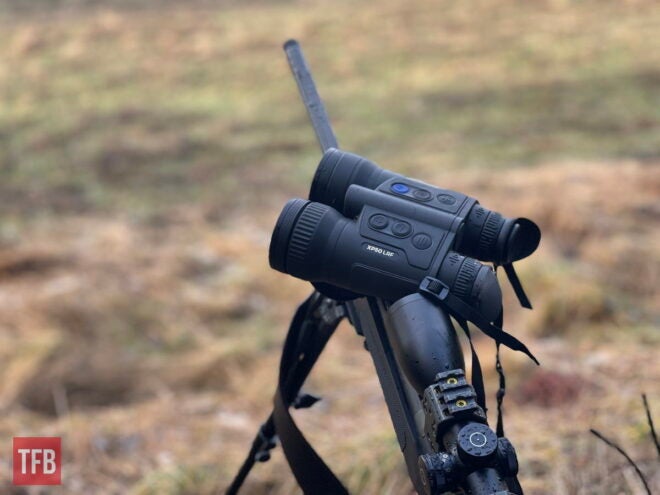
I try to use the devices we loan from Pulsar to a maximum. This image is taken on one of my hunts in December 2022. Conditions were freezing, very windy and it rained and snowed during the day. The Pulsar Merger is protected against the environment.
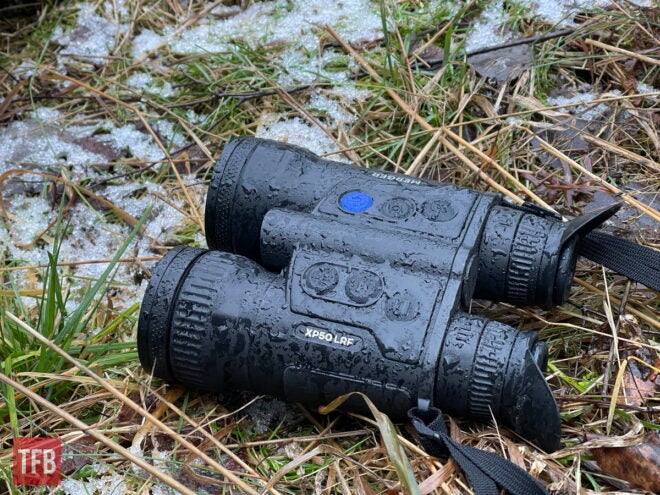
Apart from hunting, thermal binos can be used for finding anything really. Find leaking heat from your windows, ventilation, roof or building. Find missing people, or in a Law Enforcement situation, find people who are hiding.
A friend of mine runs a lot of drones of all sizes, but mostly the smaller ones. They’re all very easy to spot and follow with the Pulsar Merger. If downing drones is in your work description, the Merger will help you detect them. As an example, here you can see an osprey catching a fish. A drone is just as easy to spot, and much longer distances work as well.
Below: The Mustang GT on fire, with the red hot display mode with the Pulsar Merger LRF XP50 Thermal Binoculars. I had to pixel the license plate. Very few thermals manage to produce an image where you can read out license plates, and this is one of them!
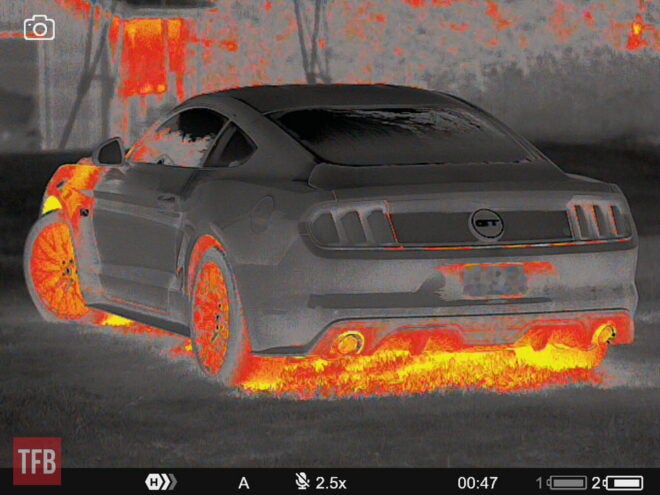
Technical Specifications
The thermal sensor is made by Lynred in France and has a 640×480 @ 17 µm, 50 Hz frame rate. The NETD is <25 mK (the lower the better). Most thermals seem to have a NETD value around 40-60 nowadays, but note that a lot of manufacturers “forget” to specify their NETD values.
The objective lens uses F50/1.0 and the binos have a magnification between 2.5 – 20 (x8 zoom). The Field of View (FOV) is between 12.4×9.3 degrees or 21.8 to 16.3 meters at 100 meters. The interpupillary distance adjustment is 62 – 74 mm, so you can adjust the eyepieces to your comfort. The eye relief is 15 mm, and you’re looking at an AMOLED HD display with 1024×768 pixels.
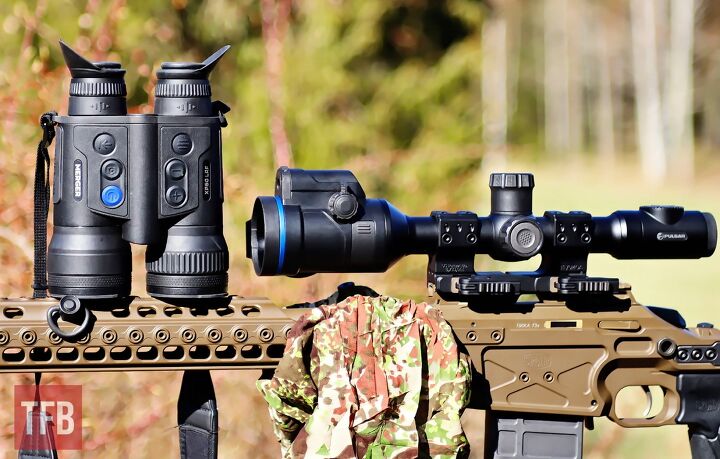
Pulsar Merger Thermal Binoculars and the Pulsar DUO Multispectral riflescope. Spuhr QD mount, so you can move it between rifles.
A low NETD value will let you see more details in the target, which helps with your target identification (finding the sow, for instance). Using both eyes and preferably a tripod for stability will further enhance your ability to ID objects further away.
Below: Moose and calf at 328 meters distance. I do a lot of “close encounters” with animals, but as you can see, distance isn’t much of an issue. The image was taken at dusk. Any warm object will stand out at much longer distances than this.
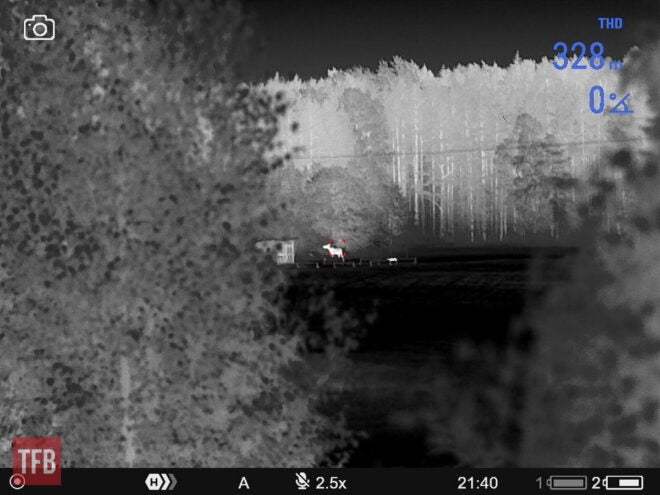
The detection range is 1800 meters, almost 2000 yards. The rangefinder laser goes out to about 1000 meters, and the readings feel accurate.
Batteries and Power
Image & Video Quality
I claim to have a good knowledge of the market, and these are the best thermal binoculars I’ve ever tested. The Merger is better than any of the monoculars I’ve tested as well. However the upcoming Pulsar Telos thermal monocular should be better with its NETD <18 mK, but the Merger has two oculars.
Until Pulsar released their XL version, with Thermal HD 1024×768 @ 12 µm (NETD <40 mK), there wasn’t much around to beat this model. I only had a brief view in the new XL, and only in perfect conditions, so I cannot compare, but for sure it will allow you to zoom in and still keep a great image.
Proximity sensor
To save battery and to avoid exposure from the backlight of the oculars in the dark, the Merger has a proximity sensor. When the device is moved away from the user’s eyes, a proximity sensor turns off both displays and when the device is brought closer, both displays are turned on and deliver high-quality images. This works great, and is an essential upgrade from the previous models. You will also save batteries.
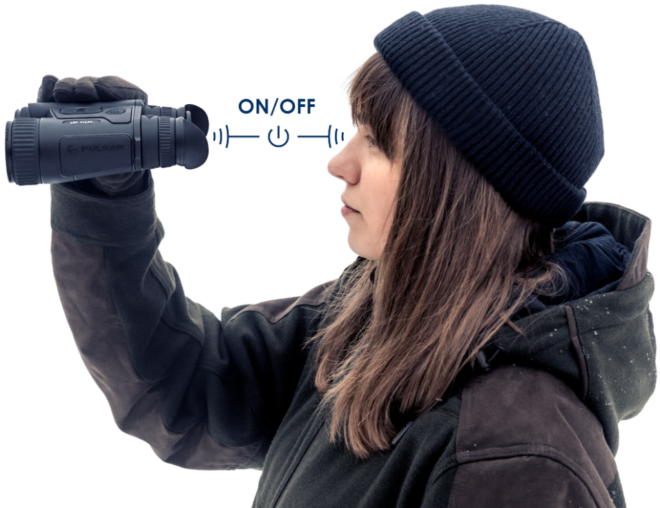
Another notable feature of the Pulsar Merger Thermal Binoculars is the built-in video recording function. This allows you to capture high-quality video footage of your observations and share them with others. The binoculars also come with a smartphone app, which allows you to control the settings and view live footage from your mobile device. However, once I have uploaded thermal images to TFB or other social media, I always feel disappointed. The original images I have from the device are much better, and the live experience I had was times better. I guess there’s a lot of detail lost as the images are compressed and resized.
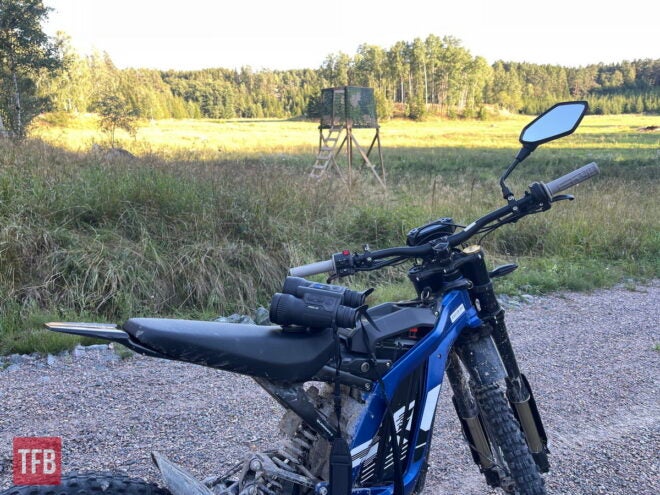
The SurRon electric moped, so you can travel without making much noise and the Merger is a great combination to find wildlife.
Below: A swimming moose very close – filmed at a wildlife park. The distance is just about 10 meters.
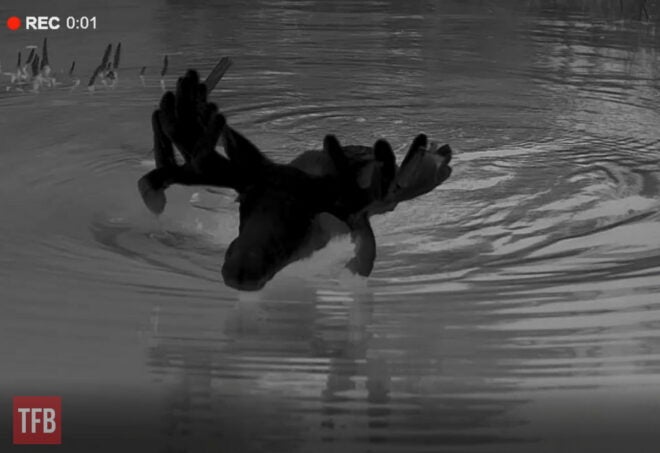
Overall, the Pulsar Merger Binoculars are an excellent choice for anyone looking for high-quality thermal imaging equipment. They are designed with both performance and convenience in mind, making them suitable for a wide range of applications. Below is a small wild boar at about 20 meters. I just scared them away, but he’s come back to see if it’s safe to continue eating.
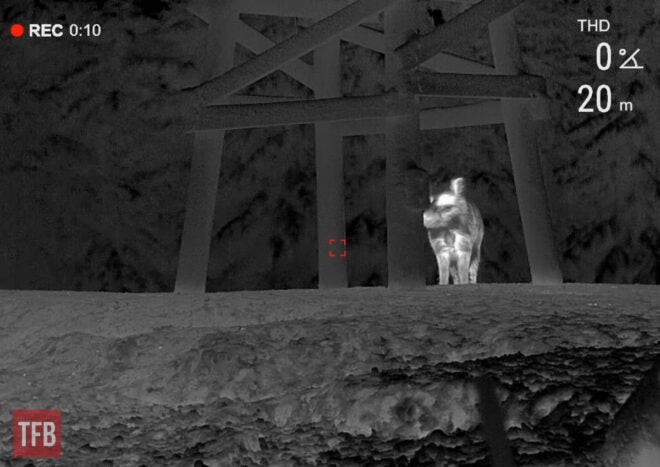
A thermal sensor with 640×480 @ 17 µm and a low NETD will help to get images like this.
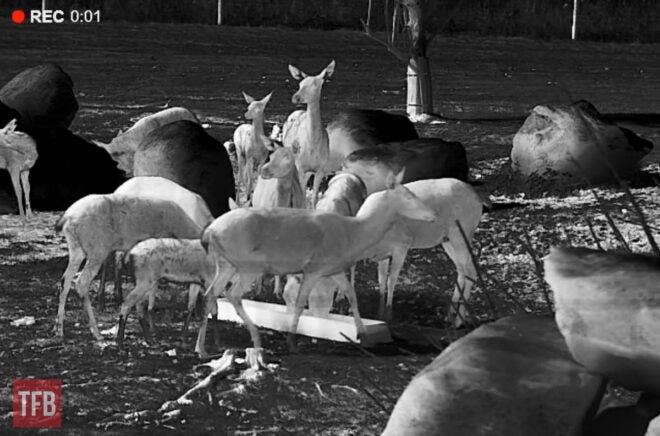
Wild Boar – Pulsar Merger Black Hot.
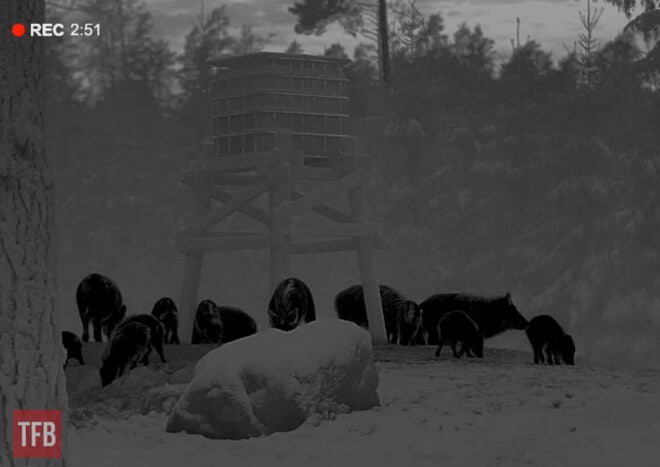
Wild Boar – Pulsar Merger White Hot (below).
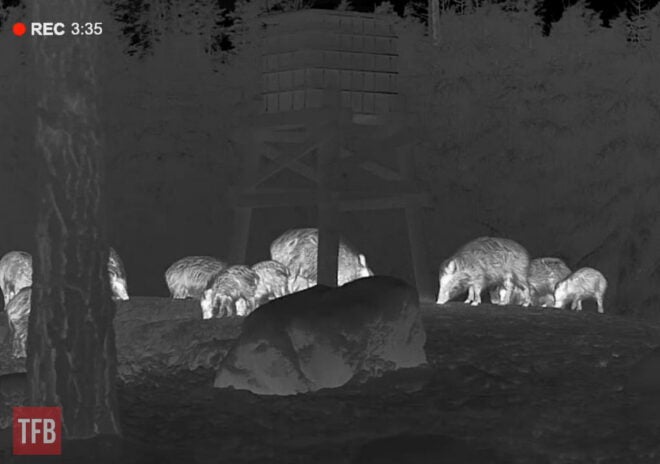
And here’s a video of what it looks like “live”.
Below: Darkness. There’s nothing out there, is there? These animals are about 200 meters away.
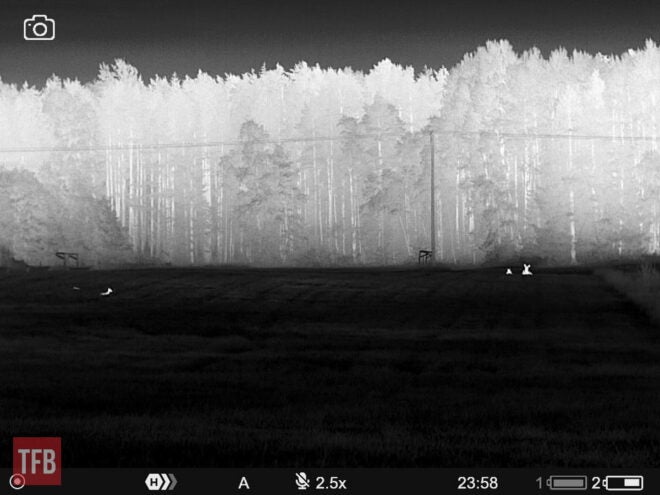
In January 2023, I took all my tripods and all the thermals I could find to check them side-by-side. It was below freezing, 10 cm of snow on the ground and full moon with some shattered clouds. The iPhone can take some really good images in darkness, it was much darker to the eye.
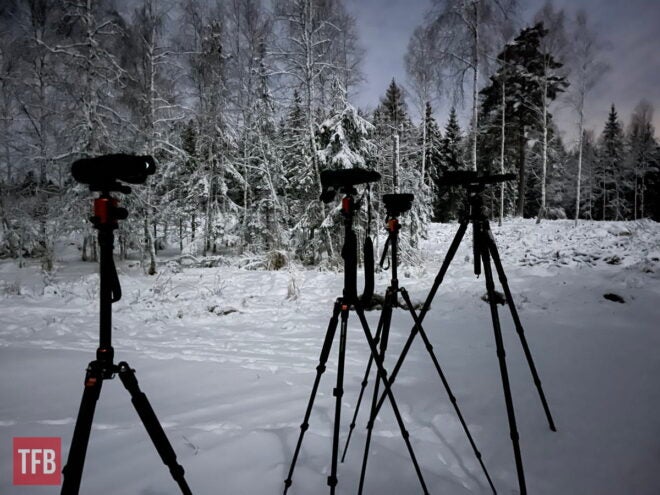
There’s no hunting by this feeder, so the wild boar feel pretty safe. Note the tripods, recording at around 20 meters.
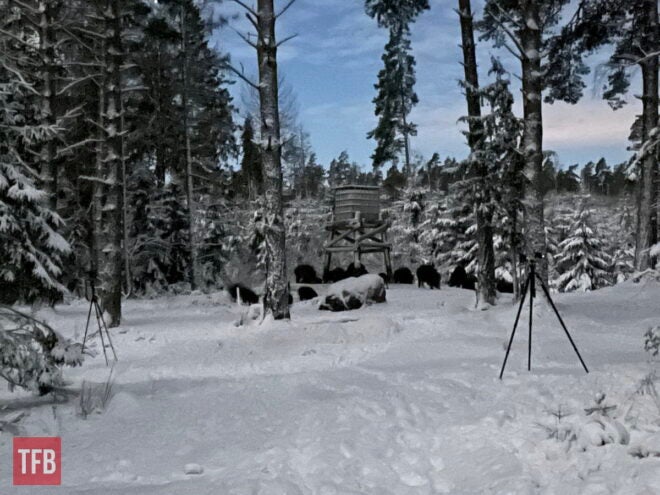
iPhone picture through one of the oculars (can’t remember which device, but probably the Merger).
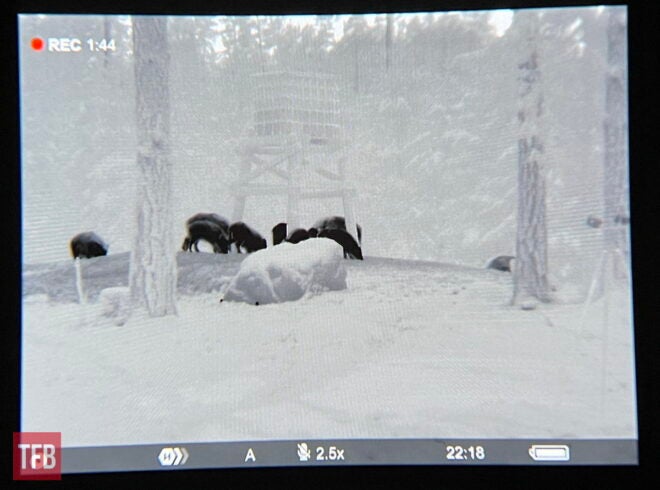
Below: The black mass in the middle is wild boar.
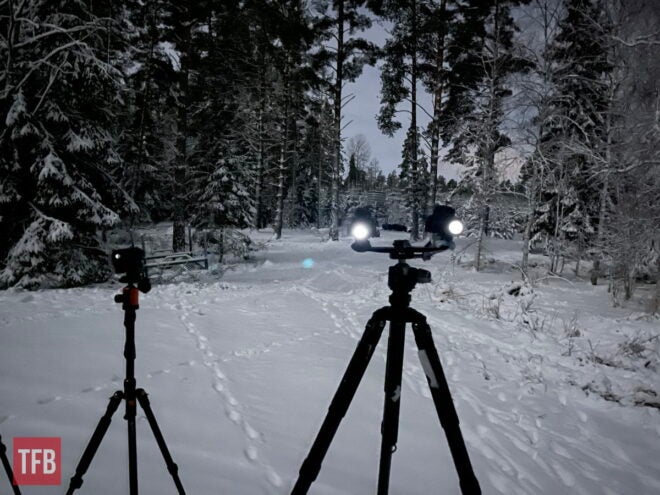
Below: Those black things are not rocks.
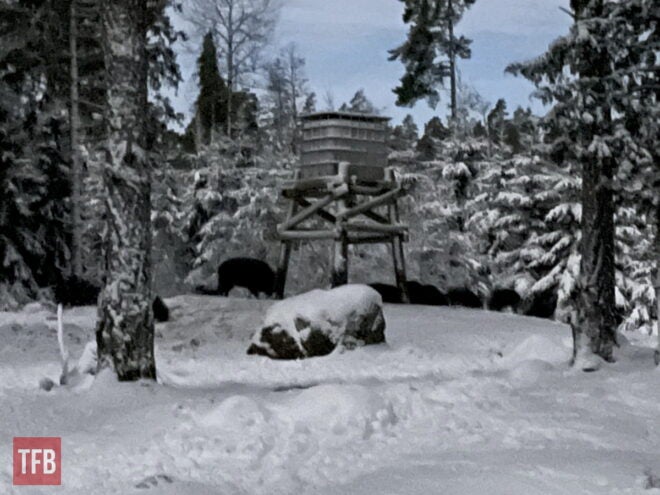
Classic binocular design: The magnesium alloy housing is light and strong at the same time. The buttons can be used with gloves on and have a good tactile feel.
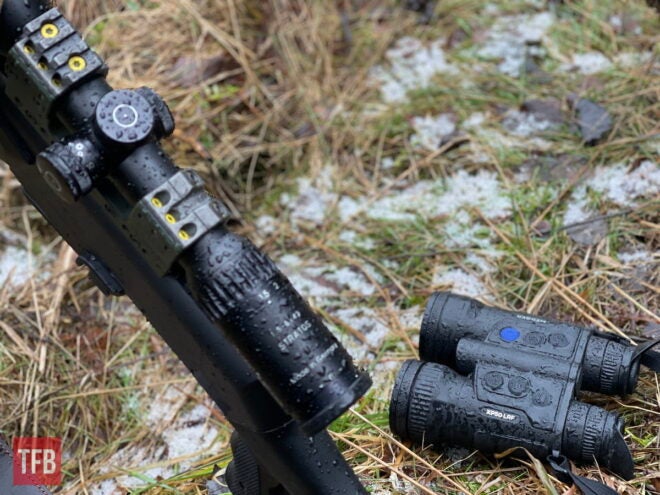
Here’s the smaller Pulsar Axion 2 XG35 (640×480 pixlar @ 12 µm NETD <40mK) to compare. If you want a pocket-friendly version, this could be an option for you?
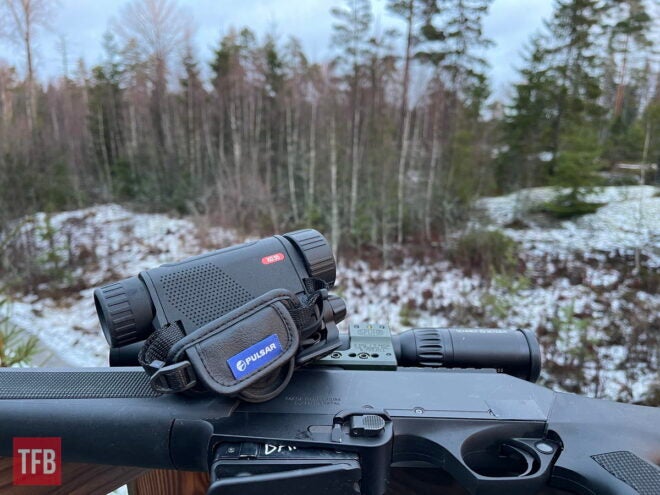
Pulsar Merger White Hot. 20 meters.
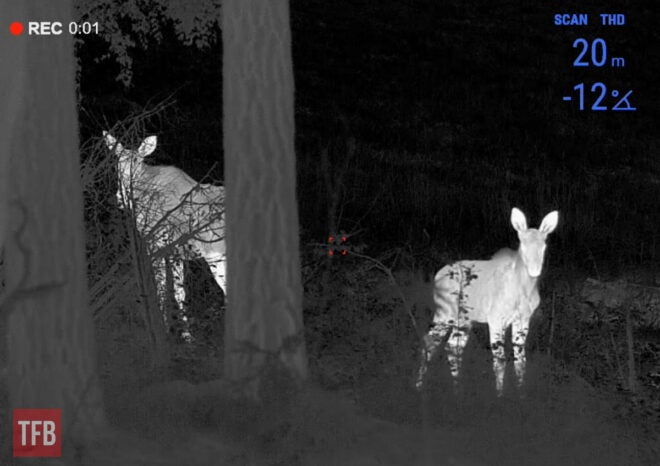
On-Screen Display makes it easy to configure the setup the way you like it, either “live” as here or in the comfort of your living room.
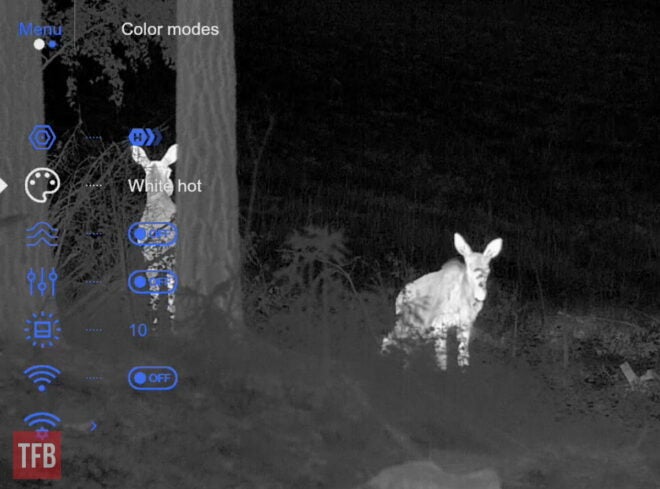
Same situation with iPhone.
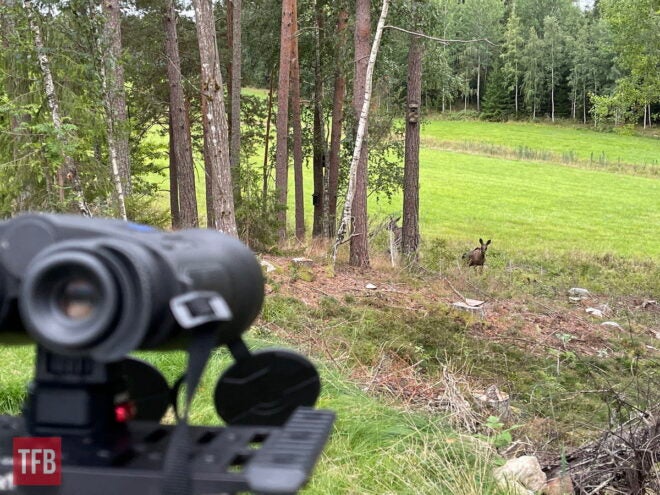
Below: Moose and calf at about 140 meters. Merger on a tripod. I hope the made the winter and the wolves.
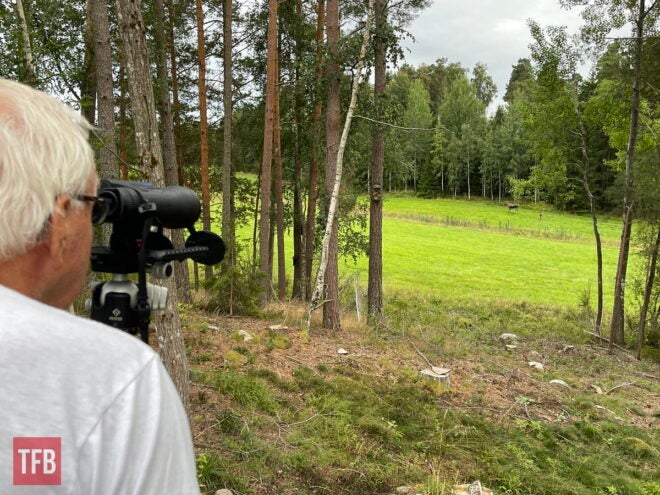
A few more videos. An osprey catches a fish. As you can image, it’s easy to discover drones (even small ones) with the Merger thermal, if that’s what you’re looking to discover.
Some houses at about 160-170 meters. Note the clarity of the image. It’s like a black and white video of reality.
Price & Availability
Pulsar doesn’t publish the MSRP, so the dealers are (somewhat) free. I’ve seen the Merger LRF XP50 for around $5,999.00 in the USA, with units on the shelf for direct shipment.
The Pulsar is Made in Lithuania (EU), including the thermal sensor.
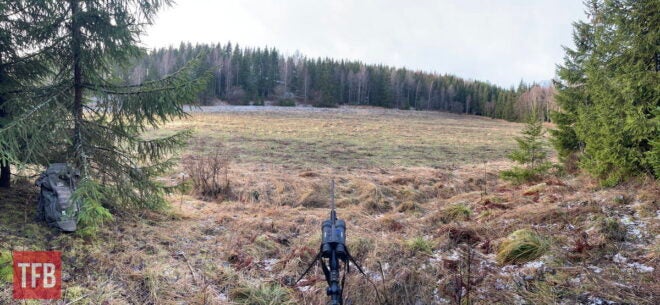
Running the Electric Motorbike (EU45) SurRon Light Bee in the woods and fields is a great nature experience. The animals don’t know what’s going on, and you can get really close. I really wish the summer was here already.
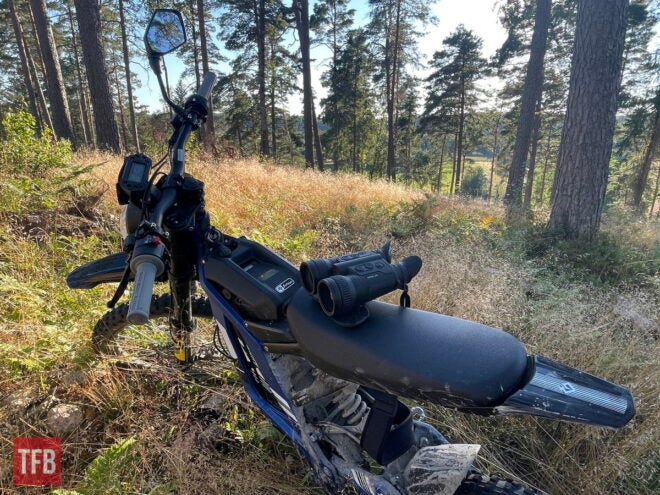
If you think the Merger XP50 or the XL50 is too much for you, take a look at the Merger LRF XQ35 (384×288 sensor) which apart from a lower price also has a smaller body size. At the time of writing, they can only be pre-ordered.

I’ve used the Merger both in dry and wet, and the thermal sensor really cuts through fog like it didn’t exist. Full moon, and here it sits side by side with two thermal riflesightscopes: the Pulsar Talion XQ38 and the Pulsar Thermion 2 LRF XP50 Pro, using The MUB to carry them all on the tripod.
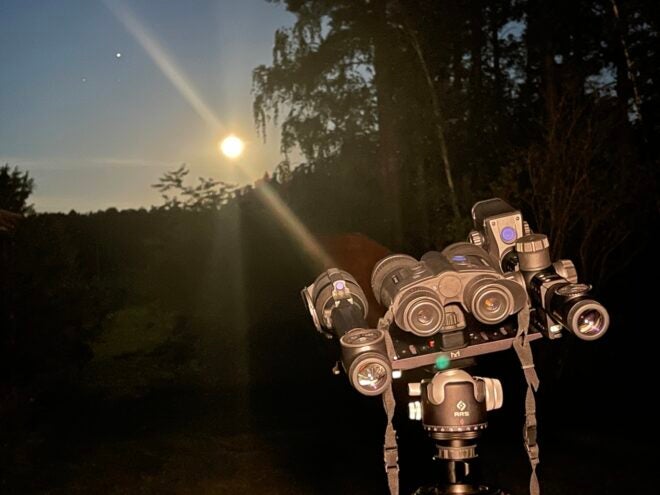
EDGE of the OUTBACK has an excellent video on the Merger, with over 20 minutes of live video.
During my review I have updated the firmware through the Stream Vision 2 app, to keep it up to date. It only takes a few minutes, and I’ve done it twice. Not because one has to, but I think there have been small improvements in image quality each time.
Positive Feedback from users
Over the past half year or so “my” Merger has been with friends (“can I please borrow it for tonight’s hunt?”) to more professional users, including security and various Law Enforcement units. The feedback has been extremely positive. The usage of this device is very easy to explain (for me), and the end result (image quality) has impressed widely even compared to devices that cost many times more (and might not be available to most of our readers.)
Problems & Issues – Room for improvement
I have had no issues with the Merger at all, apart from the ON button being a little sensitive. Pulsar should consider making this button a little less protruding, as it set the unit on a few times by accident when it was in my bag. That didn’t use to happen with the previous model (Accolade).
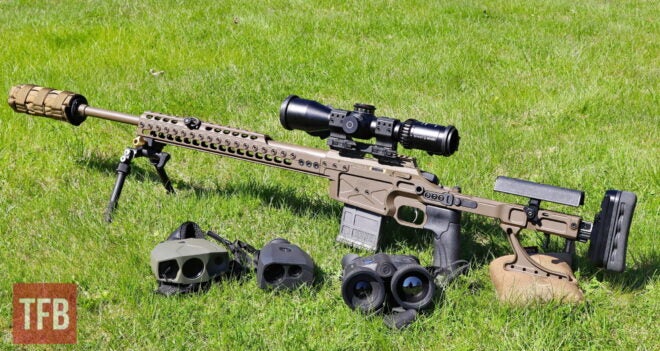
Tikka T3x TAC A1 in a Spuhr SICS chassis with the new Schmidt & Bender 5-20×52 PMII Ultra Short. There are three state-of-the-art LRFs in front. From left to right: Vectronix Terrapin X, Safran PLRF25 BLE X3 and the star in this review Pulsar Merger.
Pulsar Merger LRF XP50 Thermal Binoculars
Pros
- Easy to use and intuitive.
- Classical binocular design in a digitized version.
- Having both eyes open is more relaxing, and helps with the identification of objects and animals.
- Monoculars are smaller and cheaper, but the comfort of viewing through binoculars is outstanding.
- Can be used 24H.
- The proximity sensor works great.
- Pulsar is a well-known brand.
- Most, if not everything, is Made in Europe.
Cons
- Most TFB readers will complain about the price being a bit too high.
- The ON button should have been made less protruding.
- Both eyes open affects your eyes at night.
- Don’t look at the upcoming Merger XL – Thermal HD, unless you can afford to spend some more money.
You can find a direct link to the Pulsar Mergers here: https://www.pulsar-nv.com/glo/products/33/
(Note: Also check the Friday Night Lights: Oasys Universal Thermal Binocular (UTB), which was written after I said we never reviewed anything like this.)
We always appreciate feedback on our reviews, especially when you have something positive to say. Let us know below!
We are committed to finding, researching, and recommending the best products. We earn commissions from purchases you make using the retail links in our product reviews. Learn more about how this works.
 Your Privacy Choices
Your Privacy Choices
